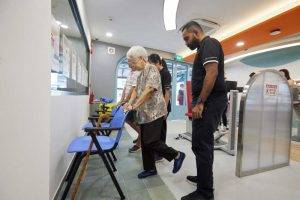Most of us do not pay much attention to our foot health until we experience an injury or encounter a problem. Before these issues set in, read on to find out 7 tips to improve foot health.
Your foot is an important body part that is often taken for granted. It takes you to places and helps you carry out day-to-day activities. Foot health is not simply about having good-looking feet (from a cosmetic point of view).
PSA: Medical Channel Asia (MCA) is now on Telegram! Join us here for daily reads and the latest updates at your fingertips!
7 Tips To Improve Foot Health
Daily care is highly essential to maintain the health of your foot. Here are 7 important tips for you to consider to improve foot health:
1. Clean your feet daily
Remember to wash your feet daily. You should not use water that is too cold or too hot for washing as it can affect the skin of your feet. Water at room temperature is ideal. You can use gentle moisturising soap to clean the foot. Once cleaned, you should pat it dry with a soft cloth and apply moisturiser.
2. Wear clean socks
If you are required to wear socks daily, ensure they are washed, cleaned, and dried. It is best to use cotton socks as they can absorb moisture. But if the weather outside is cold, you can also consider wool socks. Make sure the material is soft and does not irritate your skin. This is particularly important if you have diabetes, as diabetics are more prone to foot infections.
3. Examine your feet
It is very important to examine your feet and check for any wounds, cracks or infections. This is particularly important if you have diabetes, as you may be unable to detect the pain due to diabetic neuropathy resulting in loss of sensations. If you notice anything abnormal, consult a doctor without any delay.
4. Cut your nails regularly
You should always cut your nails straight across with a nail clipper. The corners can then be shaped with a nail file. Make sure not to cut the nails too short as it can cause them to grow inwards. Try not to share the nail clipper and nail file with others as infections can be spread through sharing of this equipment.
5. Always wear well-fitting shoes
The shoes that you select should neither be too tight nor too loose. If the shoe is very tight, it can cause blisters and wounds. On the other hand, you will find it extremely difficult to walk around in loose shoes. There should be a ½-inch gap between your longest toe and the top of the shoes. It would be best if you walked around a bit wearing the shoes before purchasing them.
Wearing shoes of the wrong size can cause corns, calluses, and blisters. Thus, it is very important to select shoes of the right size.
6. Keep your blood sugar level under control
Diabetic patients are always at risk of developing foot infections. If your blood sugar level is high, it can result in nerve damage and loss of sensation. Blood flow to your feet is also considerably reduced, leading to a longer healing time in the event of a wound on your foot.
7. Do not neglect the pain
When you are young, you may often neglect foot pain and go on with your everyday life. But this should not be the case as you grow old. If you experience pain that does not go away with proper rest and care, you should consult a doctor without delay. Proper treatment can cure most foot problems without much difficulty.
What Are Some Problems Affecting Foot?
Athlete’s foot
An athlete’s foot is a fungal infection that affects the area between the toes and the bottom of the foot. It can cause skin peeling, itching and even a burning sensation. To avoid this, you should always keep your feet clean and dry. Also, avoid walking barefoot in public areas. Anti-fungal creams are effective in treating athlete’s foot.
Blisters
Blisters are raised skin filled with fluid. It is caused by the friction between the feet and the shoes. The best way to prevent blisters is by wearing shoes of the right size. If you are using new shoes, you can wear a bandage or plaster over certain areas to prevent blisters from forming. Always allow the blisters to break on their own. It would be best to keep the area covered to prevent further friction.
Corns and calluses
Corns and calluses are thickened skin that forms on foot. While corns appear on the top and side of the toes, calluses form on the bottom of the foot. This condition is caused by the repeated rubbing of the skin against any surface. You can treat corns and calluses by removing the build-up of skin through the use of medicated plasters or liquid. Keeping the skin of your feet well moisturised also helps to soften it.
Conclusion
Maintaining foot health is not very difficult if you follow the 7 tips mentioned in this article. Wash and clean your feet daily and keep them dry. Moisturise your feet as and when needed. If you experience any difficulty or pain in the foot or notice any discolouration of the toenails, you should consult a doctor without delay.
Did you find this article useful and informative? Do you have more questions regarding this topic, or any other topics related to medical and healthcare? Send your questions to [email protected] now!











